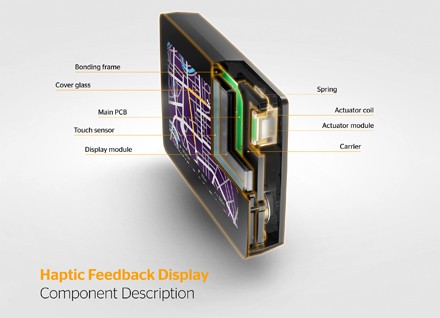 Touchscreens can cause problems in cars, because without feedback, the driver has to look at the screen to see if the operation has been completed, diverting attention off the road. Continental has created an active Haptic Feedback Display concept that provides feedback and impulses that can be felt on fingers, confirming the operation has been completed by the car.
Touchscreens can cause problems in cars, because without feedback, the driver has to look at the screen to see if the operation has been completed, diverting attention off the road. Continental has created an active Haptic Feedback Display concept that provides feedback and impulses that can be felt on fingers, confirming the operation has been completed by the car.
For car use, the touchscreen need different criteria. For example, a finely tuned force recognition (or “force sensing”) ensures that accidental touches can be distinguished from intentional operational commands.
“The clear advantage is that the driver does not have to change focus or take their eyes off the road, but instead get direct tactile feedback on the touchscreen,” said Eelco Spoelder, Head of the Continental business unit Instrumentation and Driver HMI.
The Haptic Feedback Display is due to be ready for series production by 2017. Currently there is a 8.3” model which can be scaled up to 12.3 inches.
The characteristics and intensity of the haptic feedback can be configured and adapted to the brand-specific haptic standards of OEMs. They could also be adapted to a particular driving situation as well as operating situation.
Continental haptic feedback elements, are already in widespread use. For example, the Mercedes-Benz C-Class has an optional touch pad that the infotainment system. The touch pad, based on several patented Continental technologies, such as the actuator, was presented with the “Special Award for Innovation” as part of the “Daimler Supplier Awards” in 2014.